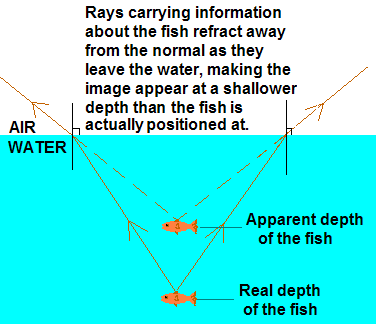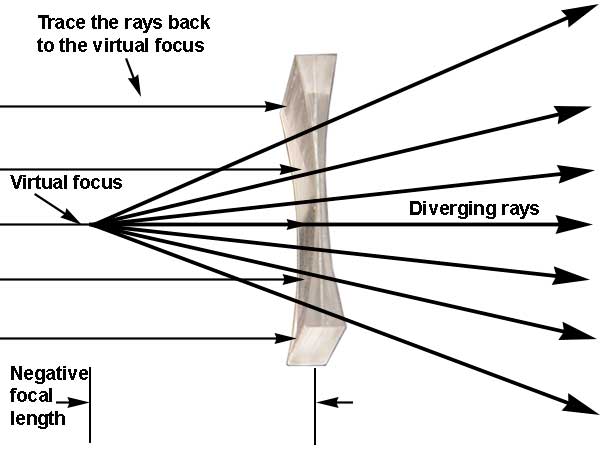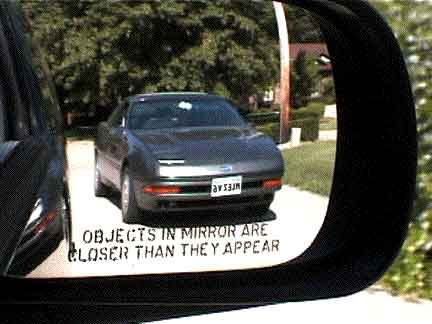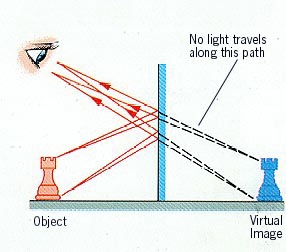A convex lens can make real or virtual image of an object depending upon the position of the object from optical centre i.e., when object lies between the principal focus F and optical centre O of the lens, the image formed is virtual and magnified.
Concave lens always produces an imaginary or virtual image independent of the position of the object from optical centre O.
Relative Position, Nature and Size of the images formed by lenses when object is moved from the surface of the lens to infinity
(a) THIN CONVEX LENS :
1. Object Between Lens and Focus F : If an object is placed between a convex lens and one of its principal focus, th rays from a point on the object will be diverging when they emerge out from the other side of the lens as shown in fig..

The diverging rays can then be focused by the eye to form a sharp magnified image on the retina. The lens used in this way is called a magnifying glass.
The image is :
1. On the same side as the object
2. Virtual and erect (upright)
3. Larger than object (magnified)
2. Object at focus F : If the object is at the principal focus, the rays from each point of the object become parallel on the other side after passing through the lens as in fig..

The image is :
1. Formed at infinity
2. Image is infinitely large
3. Object between F and 2F :
The image is :
1. Beyond 2F on the other side
2. Real and inverted
3. Larger than object (magnified).(fig. below)

1. At 2F on the other side,
2. Real and inverted,
3. Same size as object

5. Object beyond 2F :
The image is :
1. Between F and 2F on the other side
2. Real and inverted
3. Smaller than object (diminished)

6. Object at infinity :
The image is :
1. At F on the other side
2. Real and inverted
3. Much smaller than object (point image)

(b) A CONCAVE LENS :
The course of rays (see fig.) shows that the image formed by a concave lens is always virtual, erect, on that same side as the object and smaller in size.

As the object is moved from infinity to the surface of the lens, the image moves from the principal focus to the lens.
Coutesy: excellup.com
aplusphysics.com
Concave lens always produces an imaginary or virtual image independent of the position of the object from optical centre O.
Relative Position, Nature and Size of the images formed by lenses when object is moved from the surface of the lens to infinity
(a) THIN CONVEX LENS :
1. Object Between Lens and Focus F : If an object is placed between a convex lens and one of its principal focus, th rays from a point on the object will be diverging when they emerge out from the other side of the lens as shown in fig..

The diverging rays can then be focused by the eye to form a sharp magnified image on the retina. The lens used in this way is called a magnifying glass.
The image is :
1. On the same side as the object
2. Virtual and erect (upright)
3. Larger than object (magnified)
2. Object at focus F : If the object is at the principal focus, the rays from each point of the object become parallel on the other side after passing through the lens as in fig..

The image is :
1. Formed at infinity
2. Image is infinitely large
3. Object between F and 2F :
The image is :
1. Beyond 2F on the other side
2. Real and inverted
3. Larger than object (magnified).(fig. below)

4. Object at 2F :
The image is :1. At 2F on the other side,
2. Real and inverted,
3. Same size as object

5. Object beyond 2F :
The image is :
1. Between F and 2F on the other side
2. Real and inverted
3. Smaller than object (diminished)

6. Object at infinity :
The image is :
1. At F on the other side
2. Real and inverted
3. Much smaller than object (point image)

(b) A CONCAVE LENS :
The course of rays (see fig.) shows that the image formed by a concave lens is always virtual, erect, on that same side as the object and smaller in size.

As the object is moved from infinity to the surface of the lens, the image moves from the principal focus to the lens.
Coutesy: excellup.com
aplusphysics.com



















